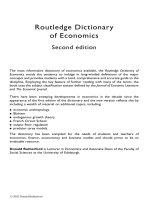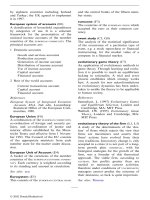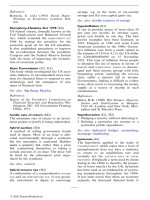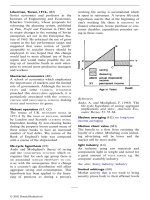Fundamentals of power system economics, second edition
Bạn đang xem bản rút gọn của tài liệu. Xem và tải ngay bản đầy đủ của tài liệu tại đây (19.95 MB, 347 trang )
FFIRS
06/13/2018
11:12:32
Page ii
FFIRS
06/13/2018
11:12:32
Page i
Fundamentals of Power System Economics
FFIRS
06/13/2018
11:12:32
Page ii
FFIRS
06/13/2018
11:12:32
Page iv
This edition first published 2019
2019 John Wiley & Sons Ltd
Edition History
1e: 2004 John Wiley & Sons Ltd
All rights reserved. No part of this publication may be reproduced, stored in a retrieval system, or
transmitted, in any form or by any means, electronic, mechanical, photocopying, recording or otherwise,
except as permitted by law. Advice on how to obtain permission to reuse material from this title is available
at />The right of Daniel S. Kirschen and Goran Strbac to be identified as the authors of this work has been
asserted in accordance with law.
Registered Office(s)
John Wiley & Sons, Inc., 111 River Street, Hoboken, NJ 07030, USA
John Wiley & Sons Ltd, The Atrium, Southern Gate, Chichester, West Sussex, PO19 8SQ, UK
Editorial Office
The Atrium, Southern Gate, Chichester, West Sussex, PO19 8SQ, UK
For details of our global editorial offices, customer services, and more information about Wiley products
visit us at www.wiley.com.
Wiley also publishes its books in a variety of electronic formats and by print-on-demand. Some content that
appears in standard print versions of this book may not be available in other formats.
Limit of Liability/Disclaimer of Warranty
While the publisher and authors have used their best efforts in preparing this work, they make no
representations or warranties with respect to the accuracy or completeness of the contents of this work and
specifically disclaim all warranties, including without limitation any implied warranties of merchantability or
fitness for a particular purpose. No warranty may be created or extended by sales representatives, written
sales materials or promotional statements for this work. The fact that an organization, website, or product is
referred to in this work as a citation and/or potential source of further information does not mean that the
publisher and authors endorse the information or services the organization, website, or product may provide
or recommendations it may make. This work is sold with the understanding that the publisher is not
engaged in rendering professional services. The advice and strategies contained herein may not be suitable
for your situation. You should consult with a specialist where appropriate. Further, readers should be aware
that websites listed in this work may have changed or disappeared between when this work was written and
when it is read. Neither the publisher nor authors shall be liable for any loss of profit or any other
commercial damages, including but not limited to special, incidental, consequential, or other damages.
Library of Congress Cataloging-in-Publication Data
Names: Kirschen, Daniel Sadi, author. | Strbac, Goran, author.
Title: Fundamentals of power system economics / by Daniel S. Kirschen,
University of Washington, United States, Goran Strbac, Imperial College
London, United Kingdom.
Description: Second Edition. | Hoboken : Wiley, [2019] | Revised edition of
the authors’ Fundamentals of power system economics, c2004. | Includes
index. |
Identifiers: LCCN 2018015513 (print) | LCCN 2018017093 (ebook) | ISBN
9781119309888 (pdf) | ISBN 9781119213253 (epub) | ISBN 9781119213246
(cloth)
Subjects: LCSH: Electric utilities. | Electric power distribution. |
Interconnected electric utility systems.
Classification: LCC HD9685.A2 (ebook) | LCC HD9685.A2 K57 2019 (print) | DDC
333.793/2–dc23
LC record available at />Cover Design: Wiley
Cover Image: onurdongel/iStockphoto
Set in 10/12 pt WarnockPro-Regular by Thomson Digital, Noida, India
Printed and bound in Singapore by C.O.S. Printers Pte Ltd
10 9 8
7 6 5 4
3 2 1
FFIRS
06/13/2018
11:12:32
Page v
For Penny and Philippe
For Dragana, Jelena, Anna, and Emily
FFIRS
06/13/2018
11:12:32
Page vi
FTOC
05/31/2018
16:50:34
Page vii
vii
Contents
Preface to the First Edition xiii
Preface to the Second Edition xv
1.1
1.2
1.2.1
1.2.2
1.2.3
1.2.4
1.2.5
1.3
1.4
1.5
1.6
1
Why Competition? 1
Market Structures and Participants 2
Traditional Model 2
Introducing Independent Power Producers 4
Wholesale Competition 5
Retail Competition 6
Renewable and Distributed Energy Resources 6
Dramatis Personae 7
Competition and Privatization 8
Experience and Open Questions 9
Problems 10
Further Reading 11
2
Basic Concepts from Economics
1
2.1
2.2
2.2.1
2.2.1.1
2.2.1.2
2.2.1.3
2.2.1.4
2.2.2
2.2.2.1
2.2.2.2
2.2.2.3
2.2.2.4
2.2.3
2.2.4
2.2.5
Introduction
13
Introduction 13
Fundamentals of Markets 13
Modeling the Consumers 13
Individual Demand 13
Surplus 14
Demand and Inverse Demand Functions 15
Elasticity of Demand 18
Modeling the Producers 18
Opportunity Cost 18
Supply and Inverse Supply Functions 19
Producers’ Revenue 20
Elasticity of Supply 20
Market Equilibrium 22
Pareto Efficiency 24
Global Welfare and Deadweight Loss 25
FTOC
05/31/2018
viii
16:50:34
Page viii
Contents
2.2.6
2.3
2.3.1
2.3.2
2.3.3
2.3.3.1
2.3.3.2
2.4
2.5
2.5.1
2.5.2
2.5.3
2.5.4
2.5.5
2.5.6
2.5.7
2.6
2.6.1
2.6.2
2.7
Time-varying Prices 26
Concepts from the Theory of the Firm 27
Inputs and Outputs 27
Long Run and Short Run 27
Costs 30
Short-run Costs 30
Long-run Costs 32
Risk 34
Types of Markets 34
Spot Market 35
Forward Contracts and Forward Markets 35
Futures Contracts and Futures Markets 37
Options 38
Contracts for Difference 39
Managing the Price Risks 40
Market Efficiency 41
Markets with Imperfect Competition 41
Market Power 41
Monopoly 42
Problems 43
Further Reading 49
3
3.1
3.2
3.3
3.3.1
3.3.2
3.3.2.1
3.3.2.2
3.3.2.3
3.3.2.4
3.3.2.5
3.3.3
3.4
3.4.1
3.4.2
3.4.3
3.4.4
3.5
3.6
Markets for Electrical Energy
4
Participating in Markets for Electrical Energy
4.1
4.2
Introduction 89
The Consumer’s Perspective
51
What Is the Difference Between a Megawatt-hour and a Barrel of Oil? 51
Trading Periods 52
Forward Markets 53
Bilateral or Decentralized Trading 54
Centralized Trading 57
Principles of Centralized Trading 57
Day-ahead Centralized Trading 59
Formulation as an Optimization Problem 60
Market Clearing Price 61
Recovering the Fixed Costs 63
Comparison of Centralized and Decentralized Trading 67
Spot Markets 68
Obtaining Balancing Resources 69
Gate Closure 70
Operation of the Spot Market 70
Interactions Between the Spot Market and the Forward Market 72
The Settlement Process 73
Problems 75
References 86
Further Reading 86
89
89
FTOC
05/31/2018
16:50:34
Page ix
Contents
4.3
4.4
4.4.1
4.4.1.1
4.4.1.2
4.4.1.3
4.4.1.4
4.4.1.5
4.4.1.6
4.4.1.7
4.4.1.8
4.4.1.9
4.4.1.10
4.4.2
4.4.3
4.4.3.1
4.4.3.2
4.4.3.3
4.4.3.4
4.4.3.5
4.4.3.6
4.5
4.5.1
4.5.2
4.5.3
4.5.3.1
4.5.3.2
4.5.3.3
4.6
4.6.1
4.6.2
4.7
4.7.1
4.7.2
4.7.3
4.8
4.9
4.9.1
4.9.2
4.9.3
4.10
The Retailer’s Perspective 91
The Producer’s Perspective 98
Perfect Competition 98
Basic Dispatch 98
Unit Limits 99
Piecewise Linear Cost Curves 100
No-load Cost 101
Scheduling 102
Startup Cost 103
Operating Constraints 104
Environmental Constraints 105
Other Economic Opportunities 105
Forecasting Errors 105
The Produce Vs Purchase Decision 105
Imperfect Competition 107
Bertrand Model 108
Cournot Model 109
Supply Functions Equilibria 116
Agent-Based Modeling 117
Experimental Economics 117
Limitations of These Models 117
Perspective of Plants That Do Not Burn Fossil Fuels
Nuclear Power Plants 118
Hydroelectric Power Plants 118
Wind and Solar Generation 119
Intermittency and Stochasticity 119
Government Policies and Subsidies 119
Effect on the Markets 120
The Storage Owner’s Perspective 121
Self-scheduling 121
Centralized Operation 122
The Flexible Consumer’s Perspective 125
Flexible Demand Vs Storage 125
Remunerating Flexible Demand 126
Implementation Issues 126
The Neighbor’s Perspective 131
An Overall Market Perspective 131
Clearing the Market 131
Exercising Market Power 133
Dealing with Market Power 135
Problems 136
Further Reading 138
5
Transmission Networks and Electricity Markets
5.1
5.2
5.2.1
141
Introduction 141
Decentralized Trading over a Transmission Network
Physical Transmission Rights 142
117
141
ix
FTOC
05/31/2018
x
16:50:34
Page x
Contents
5.2.2
5.2.2.1
5.2.2.2
5.2.2.3
5.3
5.3.1
5.3.1.1
5.3.1.2
5.3.1.3
5.3.2
5.3.2.1
5.3.2.2
5.3.2.3
5.3.2.4
5.3.2.5
5.3.2.6
5.3.2.7
5.3.2.8
5.3.2.9
5.3.3
5.3.3.1
5.3.3.2
5.3.3.3
5.3.3.4
5.3.3.5
5.3.3.6
5.3.4
5.3.4.1
5.3.4.2
5.3.4.3
5.3.4.4
5.3.4.5
5.3.5
5.3.5.1
5.3.5.2
5.3.5.3
5.3.5.4
5.4
6
6.1
6.1.1
6.1.2
6.1.3
Problems with Physical Transmission Rights 143
Parallel Paths 143
Example 144
Physical Transmission Rights and Market Power 147
Centralized Trading over a Transmission Network 148
Centralized Trading in a Two-Bus System 148
Unconstrained Transmission 149
Constrained Transmission 150
Congestion Surplus 153
Centralized Trading in a Three-Bus System 155
Economic Dispatch 156
Correcting the Economic Dispatch 159
Nodal Prices 162
Congestion Surplus 167
Economically Counterintuitive Flows 167
Economically Counterintuitive Prices 169
More Economically Counterintuitive Prices 171
Nodal Pricing and Market Power 171
A Few Comments on Nodal Marginal Prices 173
Losses in Transmission Networks 174
Types of Losses 174
Marginal Cost of Losses 174
Effect of Losses on Generation Dispatch 176
Merchandising Surplus 178
Combining Losses and Congestion 178
Handling of Losses Under Bilateral Trading 179
Mathematical Formulation of Nodal Pricing 179
Network with a Single Busbar 179
Network of Infinite Capacity with Losses 180
Network of Finite Capacity with Losses 182
Network of Finite Capacity, DC Power Flow Approximation
AC Modeling 187
Managing Transmission Risks in a Centralized Trading
System 188
The Need for Network-Related Contracts 188
Financial Transmission Rights 189
Point-to-Point Financial Transmission Rights 191
Flowgate Rights 195
Problems 195
References 202
Further Reading 202
203
Introduction 203
The Need for Operational Reliability
The Value of Reliability 204
The Cost of Reliability 204
Power System Operation
203
184
FTOC
05/31/2018
16:50:34
Page xi
Contents
6.1.4
6.1.5
6.2
6.2.1
6.2.1.1
6.2.1.2
6.2.2
6.2.2.1
6.2.2.2
6.2.2.3
6.2.3
6.2.4
6.3
6.3.1
6.3.2
6.3.3
6.3.4
6.4
6.4.1
6.4.2
6.4.3
6.4.4
6.4.4.1
6.4.4.2
6.5
6.6
7
7.1
7.2
7.2.1
7.2.2
7.2.3
7.3
7.3.1
7.3.2
7.3.3
7.3.4
7.4
7.4.1
7.4.2
7.5
Procuring Reliability Resources 206
Outline of the Chapter 206
Operational Issues 207
Balancing Issues 207
Balancing Resources 210
Effect of Generation from Stochastic Renewable Sources 212
Network Issues 212
Limits on Power Transfers 212
Voltage Control and Reactive Support 214
Stability Services 218
System Restoration 218
Market Models Vs Operational Models 219
Obtaining Reliability Resources 219
Compulsory Provision 219
Market for Reliability Resources 220
System Balancing with a Significant Proportion of Variable Renewable
Generation 221
Creating a Level-playing Field 222
Buying Reliability Resources 223
Quantifying the Needs 223
Co-optimization of Energy and Reserve in a Centralized Electricity
Market 224
Allocation of Transmission Capacity Between Energy and
Reserve 232
Allocating the Costs 237
Who Should Pay for Reserve? 237
Who Should Pay for Regulation and Load Following? 238
Selling Reliability Resources 238
Problems 243
References 246
Further Reading 247
249
Introduction 249
Generation Capacity from an Investor’s Perspective 249
Building New Generation Capacity 249
Retiring Generation Capacity 255
Effect of a Cyclical Demand 257
Generation Capacity from the Customers’ Perspective 260
Expansion Driven by the Market for Electrical Energy 261
Capacity Payments 263
Capacity Market 264
Reliability Contracts 265
Generation Capacity from Renewable Sources 266
The Investors’ Perspective 266
The Consumers’ Perspective 267
Problems 267
Investing in Generation
xi
FTOC
05/31/2018
xii
16:50:34
Page xii
Contents
References 269
Further Reading 270
8
8.1
8.2
8.3
8.3.1
8.3.2
8.3.2.1
8.3.2.2
8.3.2.3
8.3.2.4
8.4
8.4.1
8.4.2
8.4.3
8.4.4
8.4.5
8.4.5.1
8.4.5.2
8.4.6
8.4.7
8.4.8
8.4.9
8.4.9.1
8.4.9.2
8.4.9.3
8.4.9.4
8.5
8.5.1
8.5.2
8.5.3
8.6
8.6.1
8.6.2
8.7
8.8
271
Introduction 271
The Nature of the Transmission Business 272
Cost-Based Transmission Expansion 273
Setting the Level of Investment in Transmission Capacity 274
Allocating the Cost of Transmission 274
Postage Stamp Method 275
Contract Path Method 275
MW-mile Method 276
Discussion 276
The Arbitrage Value of Transmission 276
The Transmission Demand Function 278
The Transmission Supply Function 280
Optimal Transmission Capacity 281
Balancing the Cost of Constraints and the Cost of Investments 282
Effect of Load Fluctuations 283
Load-duration Curve 284
Recovery of Variable Transmission Investment Costs 287
Revenue Recovery for Suboptimal Transmission Capacity 288
Economies of Scale 290
Transmission Expansion in a Meshed Network 292
Concept of Reference Network 298
Notations 298
Problem Formulation 300
Implementation 300
Considering Other Factors 303
Other Sources of Value 303
Sharing Reserve 303
Sharing Balancing Capacity 306
Sharing Generation Capacity Margin 308
Decentralized Transmission Expansion 310
Concept 310
Illustration on a Two-bus System 311
Non-wires Alternatives for Transmission Expansion 314
Problems 315
References 316
Further Reading 317
Investing in Transmission
Index
319
FPREF1
06/01/2018
10:8:54
Page xiii
xiii
Preface to the First Edition
For about a hundred years, the electricity supply industry was in the hands of vertically
integrated monopoly utilities. During that time, engineers treated the management of
this industry as a set of challenging optimization problems. Over the years, these
optimization problems grew in size, complexity, and scope. New algorithms were
developed, and ever more powerful computers were deployed to refine the planning
and the operation of the power systems. With the introduction of competition in the
electricity supply industry, a single organization is no longer in charge. Multiple actors
with divergent or competing interests must interact to deliver electrical energy and keep
the lights on. Conventional optimization problems are often no longer relevant. Instead,
dozens of new questions are being asked about a physical system that has not changed.
To deliver the promised benefits of competition, old issues must be addressed in
radically new ways. To stay in business, new companies must maximize the value of
the service they provide. Understanding the physics of the system is no longer enough.
We must understand how the economics affect the physics and how the physics
constrain the economics.
An environment with many independent participants evolves very rapidly. Over the
last two decades, hundreds of technical papers, thousands of reports, and a few books
have been written to discuss these new issues and to propose solutions. The objective of
this book is not to summarize or repeat what is in these documents. Instead, we have
chosen to concentrate on delivering a clear and in-depth explanation of the fundamental
issues. Our aim is to give the readers a solid understanding of the basics and help them
develop innovative solutions to problems that vary in subtle ways from country to
country, from market to market, and from company to company. Therefore, we do not
discuss the organization of specific markets. Neither do we attempt to describe all the
solution techniques that have been proposed.
The plan of this book is simple. After introducing the participants to a restructured
electricity supply industry, we discuss the concepts from microeconomics that are
essential for the understanding of electricity markets. We then move on to the analysis
of the operation of power systems in a competitive environment. To keep matters
simple, we begin by ignoring the transmission network and we consider the operation
of pure energy markets. We then discuss power system security and the effects that
networks have on electricity prices. Finally, in the last two chapters, we address the
issue of investments in power generation and transmission equipment in a competitive
environment.
FPREF1
06/01/2018
xiv
10:8:54
Page xiv
Preface to the First Edition
The typical reader we had in mind while writing this book was a first-year graduate
student or a final-year undergraduate student specializing in power engineering. We
have assumed that these students know the physical structure of power systems,
understand the purpose and principles of a power flow calculation, and are familiar
with basic optimization theory. We believe that this book will also be valuable to
engineers who are working on deregulation or competition issues and who want to
acquire a broader perspective on these questions. Finally, this book might also be
useful to economists and other professionals who want to understand the engineering
perspective on these multidisciplinary issues.
Except when a specific source is cited, we have made no attempt to use or produce
realistic numbers in the problems and examples. We have used $ as a unit for money
because it is probably the best-known symbol for a currency. We could have used €, £, or
¥ instead without any change in meaning. Some of our examples refer to the fictitious
countries of Syldavia and Borduria, which are the product of the fertile imagination of the
Belgian cartoonist Hergé, creator of the character Tintin.
This book stems from our research and teaching activities in power system economics
at UMIST. We are grateful to our colleagues Ron Allan and Nick Jenkins for fostering an
environment in which this work was able to flourish. We also thank Fiona Woolf for
fascinating interdisciplinary discussions on transmission expansion. A few of our
students spent considerable time proofreading drafts of this book and checking answers
to the problems. In particular, we thank Tan Yun Tiam, Miguel Ortega Vazquez, Su
Chua Liang, Mmeli Fipaza, Irene Charalambous, Li Zhang, Jaime Maldonado Moniet,
Danny Pudjianto, and Joseph Mutale. Any remaining errors are our sole responsibility.
Manchester, England
February 2004
Daniel Kirschen
Manchester, England
February 2004
Goran Strbac
FPREF2
05/31/2018
18:19:52
Page xv
xv
Preface to the Second Edition
Since the publication of this book's first edition in 2004, competitive electricity markets
have become increasingly sophisticated. While their fundamental principles have not
changed, we felt that our text needed to be updated to more closely reflect current
practice. In particular, the phenomenal increase in the amount of energy produced from
intermittent and stochastic renewable energy sources significantly increases the uncer
tainty that power system operators and market participants have to manage. This second
edition, therefore, includes a number of new sections devoted to analyzing the effect of
uncertainty and the need for technical flexibility (e.g. from storage and the demand side)
as well as for more flexible market rules.
The chapter on system security and ancillary service has been expanded into a chapter
on power system operation and placed after the chapter on the effect of the transmission
network. We have also carefully revised the text throughout the book to reflect current
terminology and our deeper understanding of the workings of electricity markets.
We would like to thank the students and postdocs who helped us by developing some
examples and pointing out mistakes in a draft of this second edition: Bolun Xu,
Muhammad Danish Farooq, Yujie Zhou, Linyue Qiao, Mareldi Ahumada Paras, Namit
Chauhan, Ben Walborn, Dimitrios Papadaskalopoulos, Rodrigo Moreno, Yujian Ye and
Yang Yang. Any remaining errors are our sole responsibility.
Seattle, WA
March 2018
London, England
March 2018
Daniel Kirschen
Goran Strbac
FPREF2
05/31/2018
18:19:52
Page xvi
C01
06/01/2018
10:51:17
Page 1
1
1
Introduction
1.1 Why Competition?
For most of the twentieth century, when consumers wanted to buy electrical energy, they
had no choice. They had to buy it from the utility that held the monopoly for the supply of
electricity in the area where these consumers were located. Some of these utilities were
vertically integrated, which means that they generated the electrical energy, transmitted it
from the power plants to the load centers, and distributed it to individual consumers. In
other cases, the utility from which consumers purchased electricity was responsible only
for its sale and distribution in a local area. This distribution utility in turn had to purchase
electrical energy from a generation and transmission utility that had a monopoly over a
wider geographical area. In some parts of the world, these utilities were regulated private
companies, while in others they were public companies or government agencies. Irrespective
of ownership and level of vertical integration, geographical monopolies were the norm.
Electric utilities operating under this model made truly remarkable contributions to
economic activity and quality of life. Most people living in the industrialized world have
access to an electricity distribution network. For several decades, the amount of energy
delivered by these networks doubled about every 8 years. At the same time, advances in
engineering improved the reliability of the electricity supply to the point that in many
parts of the world the average consumer is deprived of electricity for less than 2 min per
year. These achievements were made possible by ceaseless technological advances.
Among these, let us mention only the development and erection of transmission lines
operating at over 1 000 000 V and spanning thousands of kilometers, the construction of
power plants capable of generating more than 1000 MW and the on-line control of the
networks connecting these plants to the consumers. Some readers will undoubtedly feel
that on the basis of this record, it may have been premature to write the first paragraph of
this book in the past tense.
In the 1980s, some economists started arguing that this model had run its course. They
said that the monopoly status of the electric utilities removed the incentive to operate
efficiently and encouraged unnecessary investments. They also argued that the cost of the
mistakes that private utilities made should not be passed on to the consumers. Public
utilities, on the other hand, were often too closely linked to the government. Politics could
then interfere with good economics. For example, some public utilities were treated as
cash cows, others were prevented from setting rates at a level that reflected costs or were
deprived of the capital that they needed for essential investments.
Fundamentals of Power System Economics, Second Edition. Daniel S. Kirschen and Goran Strbac.
2019 John Wiley & Sons Ltd. Published 2019 by John Wiley & Sons Ltd.
C01
06/01/2018
2
10:51:17
Page 2
Fundamentals of Power System Economics
These economists suggested that prices would be lower and the overall economy more
efficient if the supply of electricity was subjected to market discipline rather than
monopoly regulation or government policy. This proposal was made in the context
of a general deregulation of Western economies that had started in the late seventies.
Before attention turned toward electricity, this movement had already affected airlines,
transportation and the supply of natural gas. In all these sectors, a regulated market or
monopolies had previously been deemed the most efficient way of delivering the
“products” to the consumers. It was felt that their special characteristics made them
unsuitable for trading on free markets. Advocates of deregulation argued that the special
characteristics of these products were not insurmountable obstacles and that they could
and should be treated like all other commodities. If companies were allowed to compete
freely for the provision of electricity, the efficiency gains arising from competition would
ultimately benefit the consumers. In addition, competing companies would probably
choose different technologies. It was therefore less likely that the consumers would be
saddled with the consequences of unwise investments.
If kilowatt-hours could be stacked on a shelf – like kilograms of flour or television
sets – ready to be used as soon as the consumer turns on the light or starts the industrial
process, electricity would be a simple commodity, and there would be no need for this
book. However, despite recent technological advances in electricity storage and microgeneration, this concept is not yet technically or commercially feasible. The reliable and
continuous delivery of significant amounts of electrical energy still requires large
generating plants connected to the consumer through transmission and distribution
networks and careful attention must be paid to reliability.
In this book, we explore how various aspects of the supply of electricity can be packaged
into products that can be bought and sold on open markets. Because these products
cannot be fully separated from the supply infrastructure, we also discuss how their
trading affects the operation of the power system and, in turn, how operational
constraints impinge on the electricity markets.
In the long run, the need always arises to invest in new facilities, either because a new
technology holds the promise of greater profits or simply because equipment age and
need to be replaced. Here again we will need to examine the interplay between marketdriven behavior, physical constraints, and the need for reliability.
1.2 Market Structures and Participants
Before we delve into the analysis of electricity markets, it is useful to consider the various
ways in which they can be structured and to introduce the types of companies and
organizations that play a role in these markets. In the following chapters, we will discuss
in much more detail the function and motivations of each of these participants. Since
markets have evolved at different rates and in somewhat different directions in each
country or region, not all these entities will be found in each market.
1.2.1 Traditional Model
In the traditional market model (Figure 1.1), trading is limited to consumers purchasing
electricity from their local electric utility. This utility has two main characteristics. First, it
C01
06/01/2018
10:51:17
Page 3
1 Introduction
Figure 1.1 Traditional model of electricity supply.
has a monopoly for the supply of electricity over its service territory. If consumers want to
purchase electricity, they do not have a choice: they have to buy it from this utility.
Second, the utility is vertically integrated. This means that it performs all the functions
required to supply electricity: building generating plants, transmission lines and distri
bution networks, operating these assets in a reliable manner, and billing the consumers
for the service provided.
In a fairly common variant of the traditional model (Figure 1.2), the vertically inte
grated utility is split in two parts. One organization generates and transmits electricity
over a fairly wide area and sells it to several distribution companies (Discos), each of which
has a local monopoly for the sale of electricity to consumers.
Because monopolies could take advantage of the fact that their customers do not have a
choice to charge them extortionate prices, they must either be government entities or be
subject to oversight by a government department, which we shall call the regulator. In the
traditional model, the regulator enforces what is called the regulatory compact. This is an
agreement that gives a utility a monopoly for the supply of electricity over a given
geographical area. In exchange, the utility agrees that its prices will be set by the regulator,
that it will supply all the consumers in that area, and that it will maintain a certain quality
of service.
This model does not preclude bilateral energy trades between utilities operating in
different geographical areas. Such trades take place at the wholesale level, i.e. through
interconnections between transmission networks.
The problem with the traditional model and its variant is that monopolies tend to be
inefficient because they do not have to compete with others in order to survive.
Furthermore, because their operations are rather opaque, regulators have difficulties
assessing where improvements could be made.
3
C01
06/01/2018
4
10:51:17
Page 4
Fundamentals of Power System Economics
Figure 1.2 Variant on the traditional model of electricity supply.
1.2.2 Introducing Independent Power Producers
A first step toward a more competitive industry structure consists in allowing other
companies (called independent power producers or IPPs) to produce part of the electrical
energy that the incumbent vertically integrated utility must supply to its customers.
Figure 1.3 illustrates this arrangement. While this model introduces a degree of compe
tition at the generation level, it does not provide a mechanism for discovering costreflective prices in the same way that a free market does (see Chapter 2). The incumbent
Figure 1.3 Incumbent vertically integrated utility with independent power producers (IPPs).
C01
06/01/2018
10:51:17
Page 5
1 Introduction
utility would like to pay as little as possible for the energy produced by the IPPs to
discourage them from expanding their generation capacity. It must therefore be forced by
law to buy the power produced by the IPPs. Given this guarantee that their production
will be purchased, the IPPs will try to get as high a price as they can. This leaves the
regulator with the task of deciding what an equitable price would be. In the absence of
detailed and reliable information, the result will often be economically inefficient.
1.2.3 Wholesale Competition
A further step toward competitive electricity markets consists in getting rid of the
incumbent utility. As illustrated in Figure 1.4, all the companies that own large generating
plants (Gencos) then compete on an equal basis to sell electrical energy.
Distribution companies purchase the electrical energy consumed by their customers
on this wholesale electricity market. The largest consumers are often allowed to
participate directly in this market. As we will discuss in Chapter 3, this wholesale market
can operate in a centralized manner or can be based on bilateral transactions. In this
model, the wholesale price of electricity is determined by the interplay of supply and
demand. On the other hand, the retail price of electrical energy must remain regulated
because each distribution company retains a local monopoly over the sale of electrical
energy flowing through its network.
When the wholesale market is operated in a centralized manner, an organization called
independent system operator (ISO) must be created. This ISO has two main functions.
First, it must manage the market in an impartial and efficient manner. Second, it is
responsible for the reliable operation of the transmission system. As its name implies, to
ensure the fairness of the market, the ISO has to be institutionally independent from all
market participants.
In a bilateral wholesale market, these functions are often split between one or more
market operators (MOs), whose role is to facilitate commercial transactions between
buyers and sellers of electrical energy, and a transmission system operator (TSO), who
keeps the system in balance and operationally reliable. While TSOs often own the
transmission assets (lines, transformers, substations, etc.), ISOs usually do not.
Figure 1.4 Wholesale electricity market structure.
5
C01
06/01/2018
6
10:51:17
Page 6
Fundamentals of Power System Economics
Figure 1.5 Market with retail competition.
1.2.4 Retail Competition
Competition can also be introduced in the retail market. This leads to the structure
illustrated in Figure 1.5, where retailers purchase electrical energy in bulk on the
wholesale market and resell it to small- and medium-size consumers. In this model,
the “wires” activities of the distribution companies are normally separated from their
retail activities because they no longer have a local monopoly for the supply of electrical
energy in the area covered by their network. One can view the wholesale market as
operating over the transmission network while the retail market takes place over the
distribution network. Building and operating the transmission and distribution networks
remain monopoly activities because it is generally agreed that building competing sets of
wires would be wasteful. The regulator thus has to decide what investments in network
assets are justified and how the cost of these investments should be allocated to the users
of the networks.
Once sufficiently competitive markets have been established, the retail price no longer
has to be regulated because small consumers have the option to change retailer if they are
offered a better price or better service. As we will see in Chapter 2, from an economics
perspective, this is desirable because market interactions lead to the discovery of
economically efficient prices.
1.2.5 Renewable and Distributed Energy Resources
Over the last two decades, public policies aimed at reducing carbon emissions to mitigate
climate change have significantly altered the mix of generation technologies in many
parts of the world. Because wind and solar generation now contribute a substantial
fraction of the overall production of electrical energy, electricity markets have had to
C01
06/01/2018
10:51:17
Page 7
1 Introduction
adapt to their intermittent and stochastic nature. To deal more efficiently with the larger
imbalances between generation and load that renewable generation causes, markets
operate on a much shorter time frame than before. Another adaptation is the increasing
reliance on flexibility from the demand side to help maintain this balance. Marshaling
demand-side resources is challenging because they tend to be small and distributed
throughout the system. Direct participation in the wholesale electricity markets by
distributed energy resources (such as demand response, small-scale energy storage, and
photovoltaic generation) is not possible because it would vastly increase the number of
market participants and render these markets unmanageable. In addition, the rules of the
wholesale markets are complex and the requirements for participation are strict, making
the transaction costs prohibitively expensive for small participants. To overcome this
problem, new entities called aggregators are emerging. Their role is to serve as a
commercial and technical intermediary between the wholesale markets and the owners
of distributed energy resources who could contribute to the economic efficiency of the
overall system.
1.3 Dramatis Personae
This section summarizes the roles of the different types of organizations that operate in
the various market structures. Some of these organizations were already introduced in the
previous section. In some markets, a single commercial entity or subsidiaries of this entity
may be allowed to perform the functions of two or more of the organizations listed below.
The names given to different types of organizations may also differ from country to
country.
Vertically integrated utilities own and operate all the assets needed to supply
electrical energy: generating plants, transmission networks, and distribution networks.
In a traditional regulated environment, such a company has a monopoly for the supply of
electricity over a given geographical area. Once a wholesale electricity market has been
established, the functions and assets of the vertically integrated utilities are divided
between other types of organizations.
Generating companies (gencos) own generating plants and sell electrical energy. They
may also sell services such as regulation, voltage control and reserve that the system
operator needs to maintain the quality and operational reliability of the electricity supply.
A generating company can own a single plant or a portfolio of plants of different
technologies. Generating companies that coexist with vertically integrated utilities are
called IPPs.
Distribution companies (discos) own and operate distribution networks. Unless a
retail market has been organized, discos have a monopoly for the sale of electrical energy
to all consumers connected to their network. When a retail market is in operation, discos
are no longer responsible for the sale of energy to consumers and their role is limited to
the operation and development of the distribution network.
Retailers buy electrical energy on the wholesale market and resell it to consumers who
do not wish or are not allowed to participate in this wholesale market. Retailers do not
have to own any power generation, transmission or distribution assets. Some retailers are
subsidiaries of generation or distribution companies. All the customers of a retailer do
not have to be connected to the network of the same distribution company.
7









